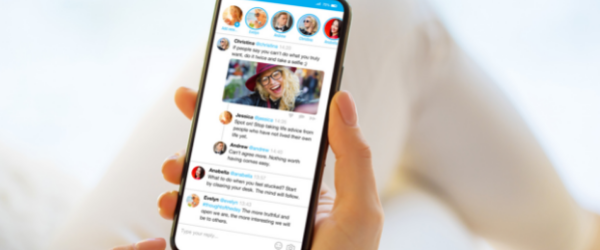Whether it’s Facebook transforming to Meta, IKEA’s fancy virtual design app or digital artwork selling for $69m, 2021 is the year that Web 3.0 crashed into the public’s consciousness.
Fresh from a COVID-induced malaise, it seems difficult to get your head around being at the start of another earth-changing event and what all this could actually mean. Words like bitcoin, crypto, metaverse and semantic-web are bandied about. It’s all a bit of a head-scratcher.
But Web 3.0 really is important. It is a radical transformation of the digital world as we know it.
Read on to learn how we got to Web 3.0 and our five predictions for changes that are going to rock the world of marketers worldwide.
A Brief History – The Journey to Web 3.0
Web 1.0 (1990-2003)
If you’re old enough to remember the early days of the internet, you’ll recall the whirring of your modem and a jolty dial-up connection that meant you got online for only an hour or so a day. You’ll have visited your favourite websites and been mesmerised by their static (can I say crappy?) website designs – check out the “impressive” CNN FN below!
Marketing was all about impressions and consumers had no way to really engage with the brands they liked. It really was all about a one size fits all, spray-and-pray approach.
Web 2.0 (2004-2020)
Now, these dates aren’t exact. But by 2004 we started to see the emergence of a new internet. The amount of information online exploded; our shiny new smartphones meant we were always online; the rise of social media heralded a new age of user-generated content. Cue my nearest and dearest knowing what I ate for my dinner every day – or tea because I’m northern.
Marketers moved quickly to reach and engage consumers all over the world. This brought novel social media campaigns and engaging on UGC sites like Reddit. In short, everyone has an opinion and creates content. The role of the marketer evolved from spraying out ads to joining and leading online conversations.

And now… Web 3.0 (2021 – onwards)
Web 3.0 might just seem like a typo but it’s an evolution of the internet predicted by the grandfather of the internet himself…no not the inventor of the first cat meme, but Tim Berners-Lee.
He predicted the emergence of Web 3.0 back in the early 2000s as a step towards a freer and fairer internet. Berners-Lee believed the web would become more human-like, capable of understanding data conceptually. Being able to make connections between different pieces of data (i.e. content) across multiple sites to provide a more personalised experience to anyone online.
Web 3.0 has also been described as the “elimination of the boundaries between digital content and physical objects that we know today”.
A seismic change that we’re only now starting to understand the potential of. As multiple new technologies converge including AI, blockchains, big data with a sprinkling of decentralisation. The opportunity for marketers to truly engage their customers online is evolving.
While brands weren’t thinking too hard about their Facebook strategy when Zuckerberg was building thefacebook.com in 2004, the history of web 2.0 definitely taught us a lesson. The longer you wait to understand the direction the internet is moving, the more painful (and costly) it will be to catch up. Read on to discover our five predictions for the future of Web 3.0
=======================================================================
5 predictions of Web 3.0 and the opportunities for brands and marketers
1. Hyper personalisation means the need for quality AND quantity
There are some lively debates regarding the role that current gatekeepers like Google will play in Web 3.0. Will updates to Google’s algorithm mean it retains a huge market share of online activity or will we see true decentralisation and a diminishing role of large tech companies? Either way, Web 3.0 means hyper-personalised content feeds based on a particular user’s data and characteristics. Someone looking for “what to eat after a run” will get different search results based on whether they’re training for a marathon or a 52-year old running newby.
There will be a steep rise in subtle and unobtrusive marketing that focuses on education and value. To create winning content, marketers will be under even more pressure to create quality authoritative content. But now with much more emphasis on quantity too.
This will require marketers to create content that covers particular topics and keywords from multiple angles and with enough depth to appeal to multiple personas. You won’t be able to rely on one huge essay to drive traffic to your site.
We will see a rise in marketing teams publishing multiple, bite-sized articles. Content that is closely related, but angled slightly differently in order to appeal to nuanced audiences.
Google is already demonstrating the power of this technique to marketing teams by surfacing multiple related articles from a single website. Moz reports that over 40% of page-one SERPs now contain indents like this:
What does this mean? As we’ve said, it’s all about quality and quantity. This hyper-personalised approach means marketing teams must strike a balance and produce more educational content that is very closely related, but angled slightly differently.
Key Takeaway 1: it’s essential to reassess your strategy and look for solutions that allow you to deploy your resources to produce more, without sacrificing quality.
2. NFT provide new ways to connect to (and monetise) an audience
As briefly mentioned at the start of this post, NFTs have been pigeon-holed as a way for artists to sell their paintings online. But they’re much more than that.
An NFT is a unique “token” that provides a digital record of ownership that can provide real-world benefits.
It’s not just about pieces of art, the blockchain technology that underpins NFTs can be leveraged by marketers to create new experiences for their customers. How?
- By issuing unique branded tokens that provide access to exclusive events
- By issuing unique branded tokens that provide early access to content
- By issuing unique branded tokens that provide access to special offers or discounts
Customers may decide to hold on to these, or they may put tokens on the market and sell them on. This is what makes NFTs exciting for content creators and as well as marketing teams. The creator (i.e. brand) can then receive a royalty every time a token is traded, creating a new revenue stream.
NFTs provide exciting novel ways for brands to monetise their following. In the US, basketball team Golden State Warriors have put their head above the parapet already, creating a number of NFTs to leverage the idolation of their fans.
Key Takeaway 2: In the very near future, marketing teams both big and small will need to create an NFT strategy as a key part of their marketing armoury.
3. A blurring of the lines between AR/VR and the real world = more juicy data
As we’ve seen, Mark Zuckerberg is taking a big bet that the metaverse is where it’s at. Depending on your point of view, the metaverse is one (or a combination) of three things:
- A dystopian Black Mirror world where humans are essentially brains in a vat that play their lives out in a virtual world
- A new space to connect with friends, family and work colleagues that feels much more engaging and life-like than a virtual call (sorry Zoom!)
- An opportunity for brands to connect to audiences through virtual experiences
We’re certain that #3 will be one that plays out. Web 3.0 will provide a hybrid space for marketers to develop connections with consumers and guide them to make more educated product decisions. Digital information will be liberated and no longer only accessed by the phones in our pockets, but by forming a “spatial-web” penetrating each part of our daily lives.
So what is holding this back right now? Allan Cook, managing director and Digital Reality Business leader at Deloitte Digital, believes the tipping point for widespread adoption is the creation of useful content. He believes that “Snap filters, where I can put a unicorn horn on my forehead, or I can change my hair green, [is] fun. But then it [Web 3.0] becomes a tool where you start to say, ‘Hey, there’s actually utility behind this. [For example] a way to trial a new shade of lipstick or hair dye, or how a piece of furniture might look in a living room”.
He comments that AR equipment will open the door for brands to have an even deeper understanding of consumers than before. By analysing tiny details like facial expressions or even an increased sweat response caused by excitement – brands will be able to target an audience with even more precision. A bit creepy, right?
Key Takeaway 3: Increased data capture provides marketing teams with the platform for more targeted and cost-effective advertising
4. Marketing teams will have to be bold and pick a side
As our worlds online and offline collide, information and experiences will increasingly transcend both. This provides marketers with the opportunity to create more touchpoints with consumers and build stronger and more loyal audiences.
But framed another way. This increased interaction also creates more opportunity for brands to offend their followers. Brand positioning is increasingly no longer about promoting a product or service as the best or cheapest, but about taking a decisive position on the most important issues of today. Climate-change, sustainability, economic uncertainty.
The humanised values that underpin Web 3.0, such as privacy, will become even more mainstream. There is going to be further momentum behind consumers preferring to buy and associating themselves with brands that they believe stand for a greater purpose than just profit. Increased connectivity provides the platform for bolder marketing campaigns and digital transformations. Create deeper connections with consumers by building communities and loyalty around campaigns. A great example of this is the the Postcode Lottery playing a key role in the WWF’s hologram elephant campaign.
Key Takeaway 4: Marketing teams will be forced to take positions on political issues that were traditionally no-go areas. They will activate their audience both online and offline with bold campaigns
5. Privacy-conscious consumers means an online advertising revolution
Now, let’s end with one of the bolder predictions. But one that is underpinned by a core facet of Web 3.0. Digital advertising will no longer be controlled by Web 2.0’s kings of the jungle Google and Facebook. Instead, consumers will be king – taking ownership of their personal data and only letting brands into their lives if they’re personally rewarded for it. Many companies including the likes of Gener8 and Brave ads are trying to crack this model. With such an incentive for any online user to adopt one of these platform, it’s hard to believe one won’t succeed.
As Gartner VP Avivah Litan believes, the key to Web 3.0 is users owning and controlling their own data, which they will be able to monetise. “Consumers will not be persuaded by search engine results, social media algorithms or online commerce platform algorithms. They will own their own algorithms that will bring them to the brands most suitable to their preferences, without any third-party intermediation and influence.”
So, what does this mean for brands and marketers? We’re entering a phase of online marketing that is the complete opposite to the spray-and-pray approach. Consumers themselves will instigate online advertising and brands will bid to get in front of them. By combining AR/VR with educational content, marketing teams will be able to create compelling and completely personalised new experiences.
By using AI to analyse the consumer’s data, brands will deeply understand how “good” a match is. Let’s look at an example of how this might work. If someone wants a new car – Audi would be able to bid to access personal data for a small fee. Once the consumer engages with the ad unit, they’ll receive their payment and be taken through a bespoke virtual showroom experience based on an analysis of their personal characteristics. A tailored and direct approach that will be several degrees more targeted and effective than a Facebook advertising campaign could ever be. Of course it won’t be easy to wrestle back control from these huge companies. But ultimately, this alternative is so much better for consumers, how can it be stopped?
Key Takeaway 5: Online advertising will no longer be a duopoly as many consumer-first startups revolutionise the online ad model
This article was written by Toby Cockayne, co-founder of inflo.Ai. To discover how inflo.Ai can help scale your content in the world of Web 3.0, click here.






